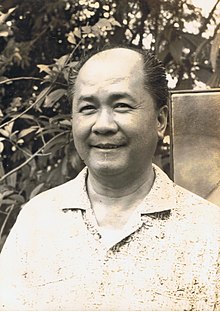| Constancio Bernardo | |
|---|---|
 Bernardo in 1969 Bernardo in 1969 | |
| Born | Constancio Ma. Anastacio Bernardo (1913-12-22)22 December 1913 Obando, Bulacan, Philippine Islands |
| Died | 8 August 2003(2003-08-08) (aged 89) |
| Nationality | Filipino |
| Education | University of the Philippines, Yale University |
| Occupation | Painter |
| Years active | 1933-2003 |
| Employer | College of Fine Arts, University of the Philippines |
| Known for | Pioneer of modern Southeast Asian abstract painting |
| Notable work | Perpetual Motion (1952) |
| Style | Geometric Abstract |
| Partner | Nieves de Guzman |
| Website | www |
Constancio Bernardo (December 22, 1913 – August 8, 2003) was a Filipino painter and professor. He is known for making the earliest modern geometric abstract paintings in the Philippines and in Southeast Asia.
Early life and education
Bernardo was born on December 22, 1913, in Obando, Bulacan, in American-occupied Philippines. He was the son of Pedro Ma. Bernardo and Cecilia Anastacio. He studied at Obando Elementary School from 1920 to 1925. In 1929, he transferred to Manila West, which is now Florentino Torres High School in Tondo, Manila, and finished his secondary education in 1933. He obtained a Bachelor of Fine Arts degree from the University of the Philippines in 1948. He was a student of Pablo and Fernando Amorsolo at the University of the Philippines School of Fine Arts before the Second World War. He earned a second Bachelor of Fine arts in 1951 and a Master of Fine Arts degree in 1952 at Yale School of Art as a Fulbright Scholar. While at Yale, he was mentored by Josef Albers who introduced him to innovative color experiments, teaching techniques and geometric abstract painting. He also took classes under Willem de Kooning and Edwin Savage.
Work
Bernardo was the subject of three major retrospectives; the first one in 1979 at the Museum of Philippine Art, the second, in 2013 at the Ayala Museum during the centenary of his birth and the third, at the Cultural Center of the Philippines in 2014. According to art critic Alice Guillermo, Bernardo was "one of the earliest and most consistent exponents of abstract art in the Philippines". She wrote in the CCP Encyclopedia of Art that Bernardo worked in series, "combining geometrism and color research in such work groupings as the Bernardian series, the Rhapsody Square series, and the Wildflower series." Bernardo was a professor of Fine Arts at the UP College of Fine Arts from 1948 to 1978.
References
- Dalisay, Butch (25 November 2013). "Constancio Bernardo, the forgotten master". philstar.com. Retrieved 21 March 2021.
- Lippi, Filipina (2 October 2014). "Celebrating Constancio Bernardo, foremost abstract artist of the Philippines". gmanetwork.com. Retrieved 21 March 2021.
- Flores, Patrick. "In the Defiles of Abstraction". CORE. Retrieved 6 February 2021.
- ^ Chikiamco, Clarissa. "Into the Light: Constancio Bernardo and Bernardian Synthesis No. 1". inquirer.net. Retrieved 6 February 2018.
- "Philippine Abstract Art" (PDF). Asia Art Archive. Retrieved 6 February 2018.
- Geronimo Cristobal (14 April 2021). Bauhaus in the Boondocks: The Modernist Lore of Constancio Bernardo. Broadcast. p. 120. ISBN 978-1-6671-5911-9.
- Carina Evangelista (18 May 2017). Constancio Bernardo. Soumak. p. 144. ISBN 978-971-94920-1-6.
- ^ Angelo Bernardo (21 March 2016). A Life in Sketches. Soumak.
- Dacanay, Barbara. "Constancio Bernardo, stalwart of Philippines abstract art, 89". inquirer.net. Retrieved 6 February 2018.
- Guillermo, Alice (3 December 1994). "Japan Foundation Symposium" (PDF). Retrieved 6 February 2021.
- Guillermo, Alice (3 December 2013). "Frisson" (PDF). Retrieved 21 February 2021.